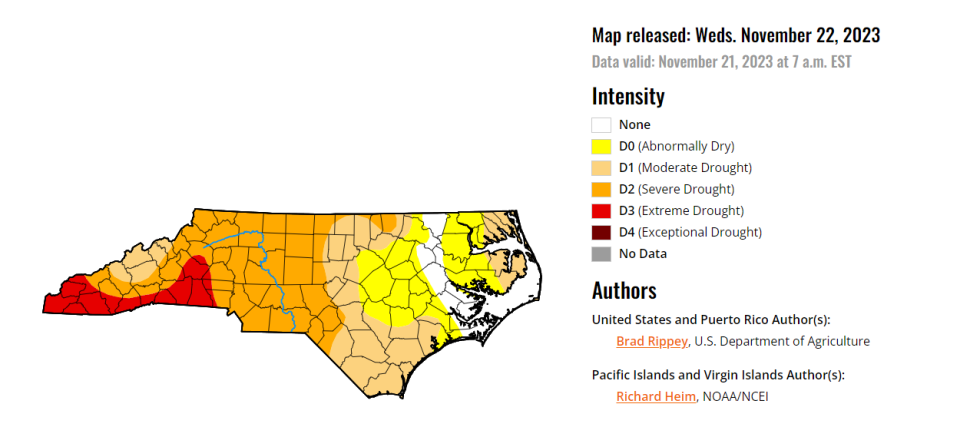'Extreme drought' conditions spread to 4 more WNC counties, even after recent rainfall
ASHEVILLE - Four more state counties ― including three in Western North Carolina ― were placed under extreme drought conditions after light rains failed to ease a growing drought in the region, according to a news release from the North Carolina Department of Environmental Quality.
Burke, Jackson and Swain Counties were added to a list of nine other WNC counties which have currently been classified under extreme drought conditions. Lincoln County, in the Piedmont, was also added to the list. Last week, drought conditions in WNC escalated from severe to extreme conditions in the 10 southernmost counties, from Cleveland County west to Cherokee County.

Additionally, severe drought conditions — a classification just below extreme — have spread to 10 more counties in the Piedmont of North Carolina. Portions of over 50 counties in North Carolina are now classified under severe drought conditions.
Across the state, all of or parts of 96 counties were classified as abnormally dry or worse. North Carolina has 100 counties.
While recent rains have failed to quench the drought, it's unlikely big systems will move into the area soon, said Klaus Albertin, chair of North Carolina's Drought Management Advisory Council.
“Typically, rain for this time a year is about an inch a week,” Albertin said in the news release. “If we get an inch and a half, it could help, but may not improve conditions dramatically. The mid- to long-term forecast is still for a wet winter due to the El Niño pattern, but it’s expected to be January before we start to see big impacts.”
During the past month of severe or extreme drought in the region, numerous wildfires have spread across WNC as the area has experienced lower rainfall than usual. High winds and extreme fire conditions have closed roads at the Great Smoky Mountains National Park, along with bringing burn bans across the region.
Buncombe County initially implemented a burn ban Nov. 6, barring residents from conducting any burn except outdoor grills. According to a Nov. 15 news release, that ban is still in effect.
Large rain system looks unlikely
Less than an inch of rain ― .78 of an inch ― fell at the Asheville Regional Airport on Nov. 21, bringing the area no closer to Asheville's yearly normal of about 44 inches of rain, National Weather Service meteorologist Christian Patterson said.
Only about 31.9 inches of rain have fallen in the Asheville area this year, she said.
"We are well below normal for this time of year and we pretty much started becoming below normal since about June," Patterson said to the Citizen Times on Nov. 22.
Additionally, no rain is expected for the coming week beyond a "very very small system" on Nov. 24, Patterson said. Moreover, no systems are currently looking to bring rain beyond the National Weather Services seven-day forecast.
"Looking into next week, we're kind of sandwiched between a really big system off in Canada. But that's not going to do anything for us," she said. "Even looking past Wednesday of next week, we still don't have any kind-of big system. So, even though El Nio is in place, we still don't have anything major on the horizon."
More: Woodfin asks for voluntary water conservation measures; WNC still in drought, has burn ban
More: Pisgah National Forest fire still 0% contained; parts of WNC worsen due to 'extreme' drought
Will Hofmann is the Growth and Development Reporter for the Asheville Citizen Times, part of the USA Today Network. Got a tip? Email him atWHofmann@citizentimes.com.
This article originally appeared on Asheville Citizen Times: Extreme drought conditions spread to 4 more WNC counties

